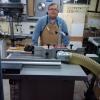Hi;
It has been about a year since my last post and I have not been in my shop since due to illness and have not really finished setting things up. I have just recently felt well enough to start working again and started building some shelves and things for the shop. Everything has sat idle for about a full year.
Now to the important part: I noticed a burnt ozone smell and found my dust collector was not working. it was a 1 1/2 hp jet with the paper filter and I had it hooked up to run 220. I started to take the motor apart and found that the large coil of coper wire around the armature was burnt and some of the strands were melted. I had the motor and fan housing mounted on a shelf above the collection bag and filter and had 4" duct run around the shop ceiling (about 10' high) and then down to the machines.
Any idea how this could have happened? I didn't have that many hours on it.




 Reply With Quote
Reply With Quote



